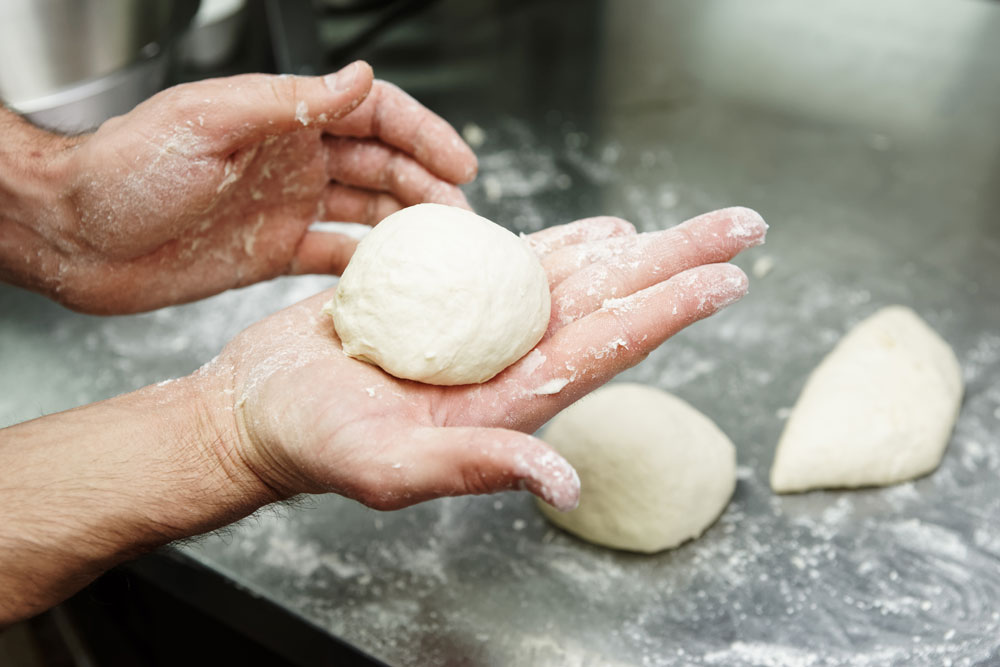Q: What are some viable alternatives to standard dough boxes?
A: Last month, we discussed using dough boxes for storing dough balls. Now let’s explore other options. We’ll start with standard aluminum bakery-sheet pans, which typically measure 18” by 26”. Like dough boxes, they must be used correctly for best results. Whereas dough boxes are self-stacking, sheet pans have to be placed into a vertical rack of some type for storage. While many racks are designed for holding sheet pans, the brackets supporting the pans are usually spaced closer together than we need: 2” as opposed to the more desirable 4”. You can still place the pans about 4” apart, but those extra brackets can snag the bags used to cover the pans—and they’re something else you have to work around. But you can live with the inconvenience if necessary. A better option is to have your shelf brackets spaced at 4” intervals, which makes for consistent pan spacing without extra brackets to get in the way as you load and unload pans.
Related: Tom Lehmann discusses thinking inside the dough box
For this type of pan, lightly oil the bottom of the pan and space dough balls at least 2” apart. Lightly oil the top of each dough ball (this prevents the plastic bag from sticking to the dough balls) and slide the pan inside a food contact-approved plastic bag that’s at least 6” longer than the pan. Place the pan into the rack, beginning at the top and working down. The bottom of the bag should then be pulled up and over the first row of dough balls on the pan, and the top of the bag should be pulled down to cover the front of the pan and tucked under the pan. The edges of the bag are now pulled down and tucked under the pan, and the pan brackets will hold the bag in place.
When removing pans from the rack, keep the bag closed and sealed to prevent drying. Allow the dough balls to warm at room temperature until they reach an internal temperature of 50°F before opening them into skins for immediate use.
This method of dough storage is very effective for those with a reach-in cooler—no cross-stacking or offset-stacking is required. The plastic bags, if kept under your control in the kitchen area, can potentially be reused several times. However, if the bagged trays of dough balls are loaded into a closed transport/wheeled rack and taken to a satellite store or location, the bags will likely be single-use only.
Bakery-sheet pans are easy to clean in hot water with a soft-bristle pot brush. However, because they are aluminum, use only plastic scrapers to lift off the dough balls and scrape dough from the pans. Since the pans are only 1” deep and fully nesting, they take up little storage or transportation space.
Related: The secrets of instant dry yeast
Another option is to bag the dough balls individually and place them on an aluminum sheet pan for storage. Using lightweight bread-type bags, lightly oil the entire dough ball and place it into the bag, pulling the bag snugly to the dough ball. Twist the open end into a ponytail and tuck it under the dough ball as it’s placed onto the sheet pan. This procedure allows the bag to slightly expand with the dough as it ferments, without rupturing or opening, as it would if the bag were tightly closed. Again, in many cases, you can reuse the plastic bags if they are kept under your control in the kitchen.
The above method of dough storage is particularly advantageous when working with high-absorption (soft/slack) dough. These dough balls tend to flow out more than those made from a lower-absorption dough, making it difficult to store them in boxes or on sheet pans. The bag controls the dough balls, allowing them to be placed onto sheet pans in a normal manner—without the need for the large bag to cover the entire pan.
This method also works when you make a limited number of dough balls or when you have little refrigerated storage space. You can individually bag all of the dough balls and place them in the cooler on sheet pans (or wherever you can fit them in), then allow them to ferment undisturbed. You can remove only the number of dough balls you need for a specific time period. And they’ll warm faster because they’re individually bagged, so, in many cases, they will be ready to open into skins within an hour or so, depending upon room temperature.
Tom Lehmann was the longtime director of bakery assistance for the American Institute of Baking and is now a pizza industry consultant.















